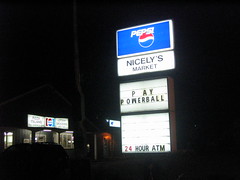A 57 megawatt wind power project has been approved for Maine's Washington County, and the 38 turbines could start spinning within a year. This is great news, of course, but, like many of Maine's proposed wind power projects, this one is going to be in the middle of nowhere, hundreds of miles away from where most people will use the electricity they generate.
This a bit unfortunate - the wind energy generated will lose a significant chunk of its power during its delivery over hundreds of miles of transmission lines - but this is how the politics of wind power work in the post-industrial state of Maine, where our primary industry now consists of simultaneously coddling the egos and satisfying the appetites of retiring baby boomers.
Putting wind turbines in a working forest near a major ski resort and hundreds of second homes (as the beat-up
Black Nubble wind project proposes) is an unacceptable violation of "pristine wilderness," but putting wind turbines in a real wilderness, far away and out of sight from rich retirees' vacation homes and resorts, garners the endorsement of every "environmental" organization in the state, even though the big transmission costs will substantially dent the project's benefits.
How closely we rely on our natural resources in Maine is something that most people, honestly or not, say that they admire about our state. Who doesn't get a hackle-raising thrill when some jerk from Massachusetts whines about the smell of fish from the quaint lobster pound next door to his new multi-million dollar cottage? "This is Maine," we shout. "This is our tradition of living off the land and sea! This is where food comes from! Suck it up and deal!"
The same protest should apply to people who whine about the sight of electricity being made - the board members and major donors of Maine Audubon and the Appalachian Mountain Club who are dead set against seeing wind turbines through the picture windows of their ski condos. While we wait for them to resolve their blinkered environmental ethics (this could take a while), we'll need to come up with other solutions without them.

In Portland, residents are beginning to talk about setting up test anemometers on the crest of the Eastern Prom, where the peninsula separates Back Cove from the rest of the harbor. It looks like a fantastic wind power site, with open water to the east and west and a hillside that runs perpendicular to prevailing winds (the "wind rose" above shows the typical frequency and strength of winds in the area). Turbines here would not have to lose energy by traveling for miles on the transmission grid: here's a chance for the "Portland Buy Local" movement to make a meaningful move into the energy sector.
Plus, it's a highly visible site - as well as the home of Portland's first certified green building (the East End School). I suspect that most Portlanders would consider turbines here more a source of civic pride than an "eyesore".

Portland wouldn't be the first city to give a wind turbine or two a prominent spot:
Toronto has one, as does the
town of Hull on the eastern end of Boston Harbor, and
the IBEW union in Dorchester installed a turbine right next to I-93.
So, is Portland really a "sustainable" city? Let's put our money where our mouth is by building windmills where the views are.















